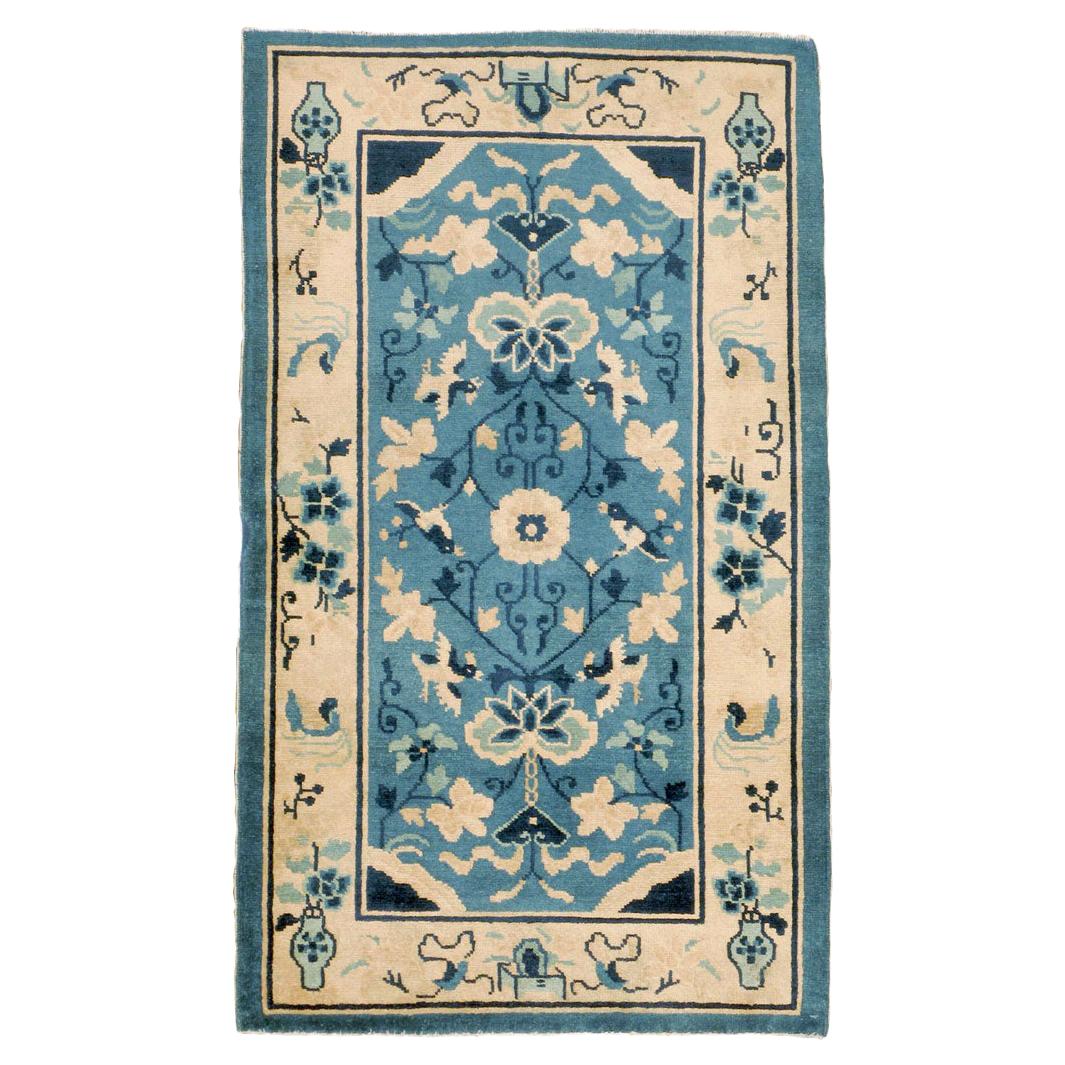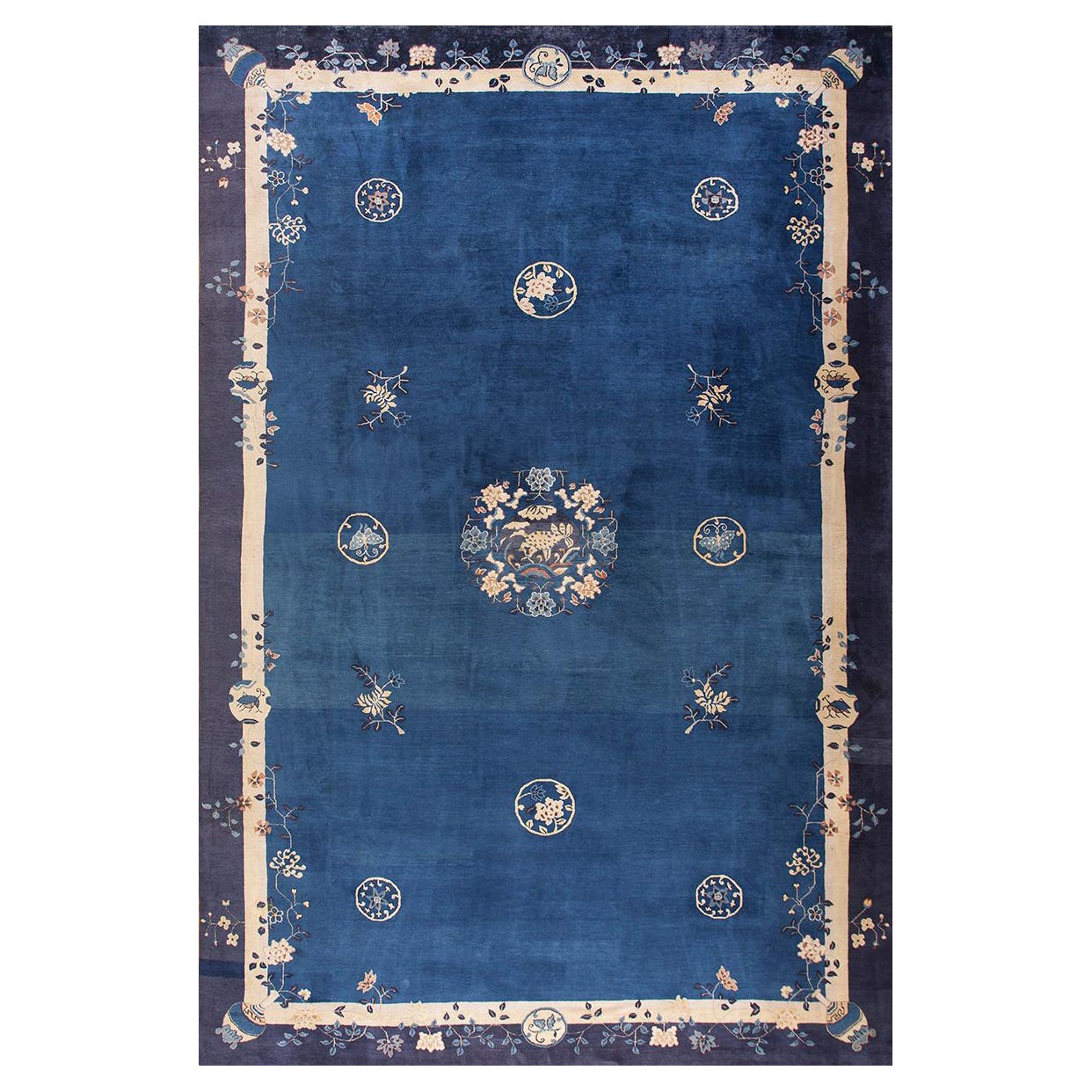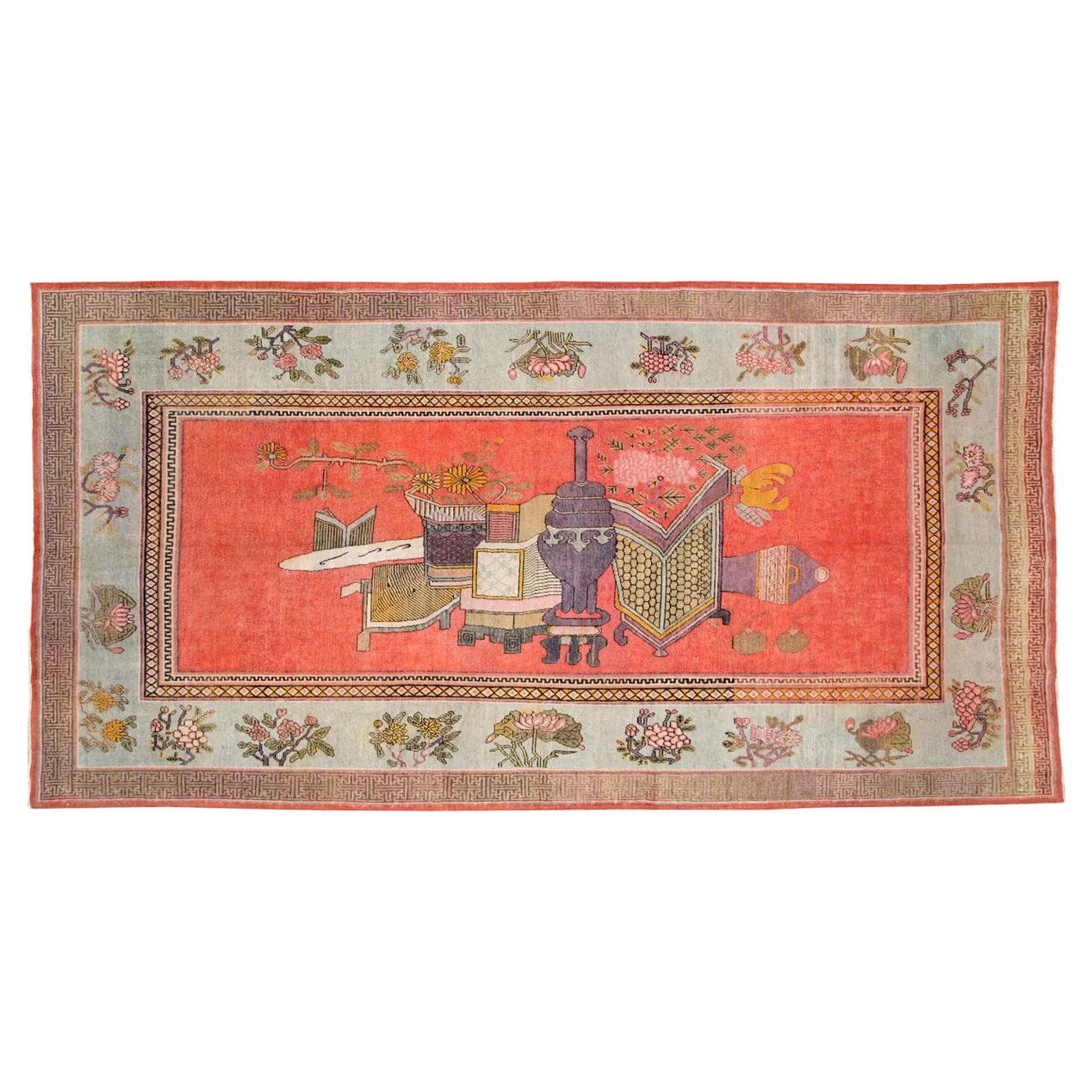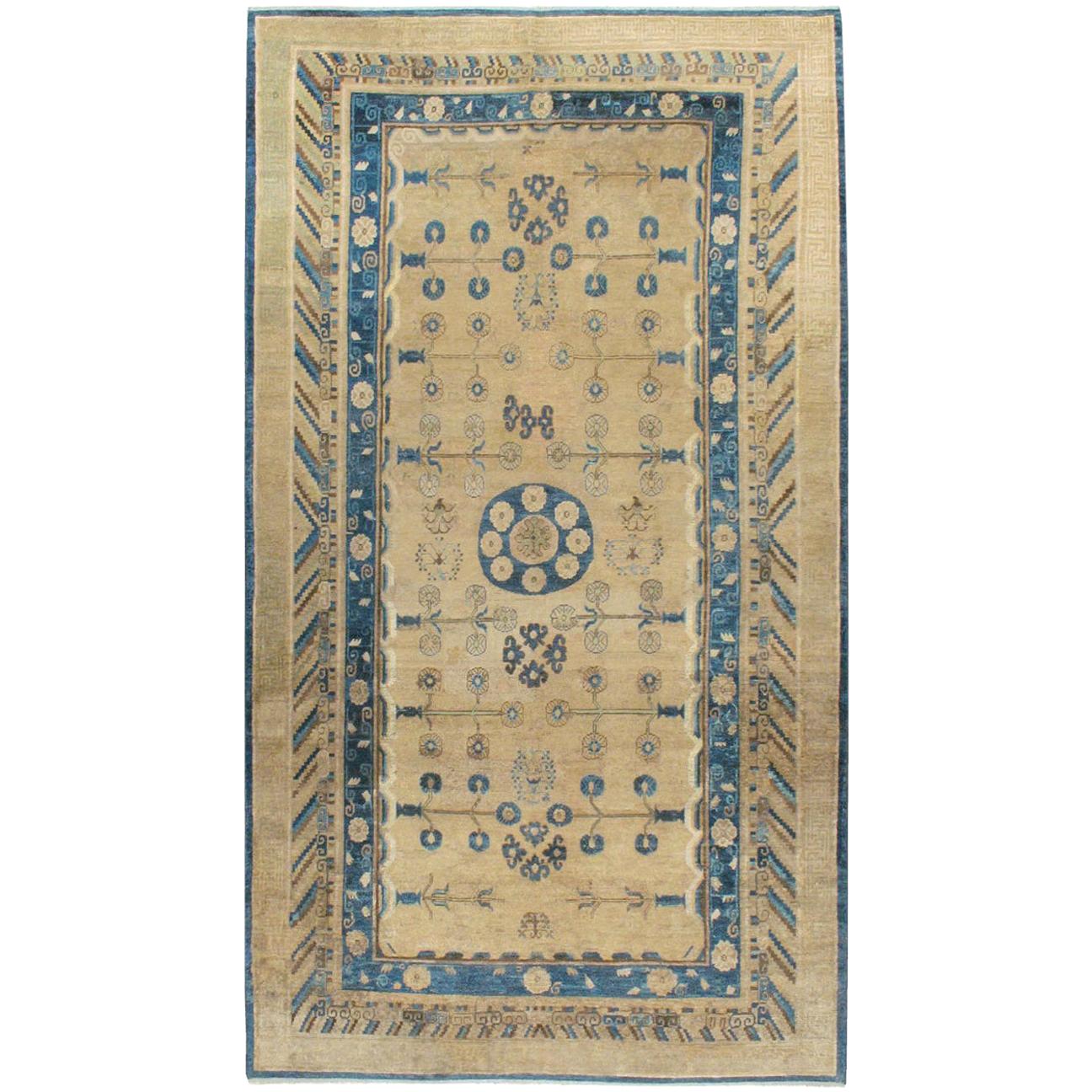Items Similar to Early 20th Century Handmade Chinese Peking Long Gallery Carpet in Cream & Blue
Want more images or videos?
Request additional images or videos from the seller
1 of 11
Early 20th Century Handmade Chinese Peking Long Gallery Carpet in Cream & Blue
About the Item
An antique Chinese Peking long gallery carpet handmade during the early 20th century in shades of cream and blue.
Measures: 5' 9" x 16' 3"
The craft of the hand-knotted carpet in China, and the surrounding areas including Mongolia and Tibet, extends into the early centuries of the first millennium, C.E., but we really have a firm grasp only beginning in the later 16th century with large, very coarsely woven carpets, often depicting dragons, created for the Imperial Forbidden City palaces. Chinese carpets have always been commercial and there are no tribal groups responsible for any of the carpet weaving strains.
When the Ming Dynasty fell in 1644, with no Imperial patrons, production moved to the city of Ningxia in north central China where several workshops turned out more finely woven pieces for the Mandarins of the administrative Ch’ing bureaucracy and well-to-do merchants. Ningxia was the major Chinese carpet center up through most of the 19th century, with first allover and then medallion designs on cotton foundations in medium weaves. Palettes were initially limited to yellows, dark blue and cream, but later widened to include reds, browns and even green. These antiques were the first Chinese carpets to be exported to the West and they fitted in well with the craze for Chinese blue-and-white porcelain in the second half of the 19th century. Ningxia also wove shaped and rectangular small rugs for saddle underlays, chair (“throne”) seats and shaped backs, pillar carpets with dragons or monks for Buddhist monasteries, and long divided runners for monastery meditation halls. These small rugs are among the most collectible of all Chinese weavings.
Weavers from Ningxia set up workshops in the capital Peking (Beijing) in the 1860’s and began weaving Western room sizes for export, primarily to America. In blue – and – white and polychrome palettes, with round wreath medallions, precious objects, seasonal flowers, paeonies, lotuses, fretwork, clouds, butterflies and bats, all relatively spaciously drawn. The round “Shou” (Good Luck) character is also a prominent decorative motif. There are also a few Peking landscape pictorials with pagodas, houses, bridges, waterscapes and boats. Peking carpets were woven right up until WWII and production began again after the Cultural Revolution around 1970. They are moderately well-woven, on cotton foundations, exactingly executed and indisputably Chinese. Many are in the blue-and-white style. Nothing else looks like a Peking carpet and for a Chinese “look” in a room, they are absolutely indispensable. Sizes range from scatters and a few runners, through the popular 9’12’ size, to large carpets over 20’ which must have been special orders. The earliest Peking Revival carpets are pliable and fairly thin, but they became heavier and more compact in the 20th century, in competition with Art Deco carpets from Tientsin. The modern, post- 1970, pieces are in the traditional Peking style, but are a little too regular and neat. Exactitude has been favored over character, as hard to explain that as it is.
There are a number of all-silk and silk-and –metal thread pieces, many with inscriptions purporting to link them with rooms in the Imperial palaces, bringing very substantial auction prices, but none are really antique. The genre emerged after WWI and the present demand comes from mainland Chinese. The silk piles often stand in pattern relief against flat woven gold metal thread grounds. The inscriptions are apocryphal, the rugs are flashily opulent, perfect for nouveaux riches.
The Art Deco period between the two World Wars saw a distinctive carpet industry developing in Tientsin (Tianjin) in northeastern China. These are highly prized for their transitional design character, neither overtly Chinese, nor abstractly modern/contemporary. Woven exclusively for export, usually by and for American firms, such as Nichols and Elbrook, they are totally in the “Jazz Age Modern” style of the 1920’s, often without borders, with abstract or abstracted patterns, and only with, at best, a few Chinese-y pattern elements. Vases asymmetrically placed in the corners are features of some of the more Chinese-y carpets. Open fields with floral sprays and branches growing in from the edges are anther design innovation. Often, Chinese motives have been re-imagined in more sharp-edged, abstract manners. Some have no references whatsoever to natural elements. The patterns are sharp and the rugs are never subdued, soft or restrained. The rugs are heavily constructed, with crisp, unfading dyes and medium to medium coarse weaves on cotton foundations. All are extremely well-executed, with none of the vagaries, variations or twists found on even high-quality Persian rugs. The majority are in the 9’ by 12’ format and a surprising number can be found in top condition. There also was a substantial production in Peking from, especially from the Fette factory. Elliptical and round carpets, and lighter, often pastel colors, were a specialty. Nothing looks like an Art Deco Chinese and they work well with traditional Chinese furniture and the most modern decor as well. These is no substitute for a good Chinese Art Deco carpet.
Chinese carpets also include small scatters from Tibet, with high quality wool, floating dragons and allover textile patterns. The colors of vintage and modern pieces are bright, but there are antique small rugs (sleeping rugs) with simple chessboard allovers. Only a few large antique Tibetan carpets are known. Also grouped as Chinese are the boldly drawn, usually square large carpets assigned to Inner Mongolia. These look like Peking Revival pieces, but show fewer and larger patterns, usually with central medallions or “Shou” characters. They are generally fairly thin, on cotton foundations. Their exact origins are still mysterious.
Pictorial small rugs are woven in the town of Bao-Tou, with deer and Taoist Immortals. Scatters from the town of Suiyuan often show “grains of rice” small overall patterns.
Chinese rugs are all woven in factory settings, with numerous upright looms, and copious, drone-like weavers. There is no tradition of innumerable dispersed villages as in Persia or Turkey, or nomadic tribes as in Central Asia or Morocco. Rug weaving, like other Chinese art industries, is a commercial enterprise relying on an extremely efficient organization from wool selection to final finishing, geared to large-scale, uniformly high quality production. The resulting carpets are always well-executed and many rise to the level of real art.
About the Seller
5.0
Platinum Seller
These expertly vetted sellers are 1stDibs' most experienced sellers and are rated highest by our customers.
Established in 1989
1stDibs seller since 2009
562 sales on 1stDibs
Typical response time: 1 hour
- ShippingRetrieving quote...Ships From: New York, NY
- Return PolicyA return for this item may be initiated within 3 days of delivery.
More From This SellerView All
- Early 20th Century Handmade Chinese Peking Long Room Size CarpetLocated in New York, NYAn antique Chinese Peking long and narrow format room size carpet handmade during the early 20th century. Measures: 9' 10" x 16' 2".Category
Early 20th Century Chinese Art Deco Chinese and East Asian Rugs
MaterialsWool
- Mid-20th Century Handmade Chinese Peking Throw Rug in Cream and Light BlueLocated in New York, NYA vintage Chinese Peking throw rug handmade during the mid-20th century with a cream border and light blue field. Measures: 2' 6" x 4' 3" The craft of the hand-knotted carpet in China, and the surrounding areas including Mongolia and Tibet, extends into the early centuries of the first millennium, C.E., but we really have a firm grasp only beginning in the later 16th century with large, very coarsely woven carpets, often depicting dragons, created for the Imperial Forbidden City palaces. Chinese carpets have always been commercial and there are no tribal groups responsible for any of the carpet weaving strains. When the Ming Dynasty fell in 1644, with no Imperial patrons, production moved to the city of Ningxia in north central China where several workshops turned out more finely woven pieces for the Mandarins of the administrative Ch’ing bureaucracy and well-to-do merchants. Ningxia was the major Chinese carpet center up through most of the 19th century, with first allover and then medallion designs on cotton foundations in medium weaves. Palettes were initially limited to yellows, dark blue and cream, but later widened to include reds, browns and even green. These antiques were the first Chinese carpets to be exported to the West and they fitted in well with the craze for Chinese blue-and-white porcelain in the second half of the 19th century. Ningxia also wove shaped and rectangular small rugs for saddle underlays, chair (“throne”) seats and shaped backs, pillar carpets with dragons or monks for Buddhist monasteries, and long divided runners for monastery meditation halls. These small rugs are among the most collectible of all Chinese weavings. Weavers from Ningxia set up workshops in the capital Peking (Beijing) in the 1860’s and began weaving Western room sizes for export, primarily to America. In blue – and – white and polychrome palettes, with round wreath medallions, precious objects, seasonal flowers, paeonies, lotuses, fretwork, clouds, butterflies and bats, all relatively spaciously drawn. The round “Shou” (Good Luck) character is also a prominent decorative motif. There are also a few Peking landscape pictorials with pagodas, houses, bridges, waterscapes and boats. Peking carpets were woven right up until WWII and production began again after the Cultural Revolution around 1970. They are moderately well-woven, on cotton foundations, exactingly executed and indisputably Chinese. Many are in the blue-and-white style. Nothing else looks like a Peking carpet and for a Chinese “look” in a room, they are absolutely indispensable. Sizes range from scatters and a few runners, through the popular 9’12’ size, to large carpets over 20’ which must have been special orders. The earliest Peking Revival carpets are pliable and fairly thin, but they became heavier and more compact in the 20th century, in competition with Art Deco carpets from Tientsin. The modern, post- 1970, pieces are in the traditional Peking style, but are a little too regular and neat. Exactitude has been favored over character, as hard to explain that as it is. There are a number of all-silk and silk-and –metal thread pieces, many with inscriptions purporting to link them with rooms in the Imperial palaces, bringing very substantial auction prices, but none are really antique. The genre emerged after WWI and the present demand comes from mainland Chinese. The silk piles often stand in pattern relief against flat woven gold metal thread grounds. The inscriptions are apocryphal, the rugs are flashily opulent, perfect for nouveaux riches. The Art Deco period between the two World Wars saw a distinctive carpet industry developing in Tientsin (Tianjin) in northeastern China. These are highly prized for their transitional design character, neither overtly Chinese, nor abstractly modern/contemporary. Woven exclusively for export, usually by and for American firms, such as Nichols and Elbrook, they are totally in the “Jazz Age Modern” style of the 1920’s, often without borders, with abstract or abstracted patterns, and only with, at best, a few Chinese-y pattern elements. Vases asymmetrically placed in the corners are features of some of the more Chinese-y carpets. Open fields with floral sprays and branches growing in from the edges are anther design innovation. Often, Chinese motives have been re-imagined in more sharp-edged, abstract manners. Some have no references whatsoever to natural elements. The patterns are sharp and the rugs are never subdued, soft or restrained. The rugs are heavily constructed, with crisp, unfading dyes and medium to medium coarse weaves on cotton foundations. All are extremely well-executed, with none of the vagaries, variations or twists found on even high-quality Persian rugs. The majority are in the 9’ by 12’ format and a surprising number can be found in top condition. There also was a substantial production in Peking from, especially from the Fette factory. Elliptical and round carpets, and lighter, often pastel colors, were a specialty. Nothing looks like an Art Deco Chinese and they work well with traditional Chinese furniture and the most modern decor as well. These is no substitute for a good Chinese Art Deco carpet. Chinese carpets also include small scatters from Tibet, with high quality wool, floating dragons and allover textile patterns. The colors of vintage and modern pieces are bright, but there are antique small rugs...Category
Mid-20th Century Chinese Art Deco Chinese and East Asian Rugs
MaterialsWool
- Late 20th Century Handmade Chinese Peking Room Size Carpet in Blue and MauveLocated in New York, NYA vintage Chinese Peking room size carpet handmade during the late 20th century in blue, mauve, and cream. Measures: 9' 1" x 11' 9".Category
Late 20th Century Chinese Chinese Chippendale Chinese and East Asian Rugs
MaterialsWool
- Early 20th Century Handmade East Turkestan Khotan Gallery Carpet, circa 1900Located in New York, NYAn antique East Turkestan Khotan gallery format carpet handmade during the turn of the 20th century. Measures: 7' 2" x 12' 10".Category
Early 20th Century East Turkestani Rustic Chinese and East Asian Rugs
MaterialsWool
- Early 20th Century Handmade East Turkestan Khotan Pictorial Vase Gallery CarpetLocated in New York, NYAn antique East Turkestan Khotan gallery carpet handmade during the early 20th century with a pictorial vase design. Measures: 6' 8" x 12' 10".Category
Early 20th Century East Turkestani Chinoiserie Chinese and East Asian Rugs
MaterialsWool
- Early 20th Century Chinese Peking Large Room Size RugLocated in New York, NYAn antique Chinese Peking large room size carpet handmade during the early 20th century. Measures: 10' 10" x 15' 2".Category
Early 20th Century Chinese Art Deco Chinese and East Asian Rugs
MaterialsWool
You May Also Like
- Early 20th Century Chinese Peking Carpet ( 11'9" x 17' - 358 x 518 )Located in New York, NYEarly 20th Century Chinese Peking Carpet ( 11'9" x 17' - 358 x 518 )Category
Vintage 1910s Chinese and East Asian Rugs
MaterialsWool
- Early 20th Century Chinese Peking CarpetLocated in New York, NYEarly 20th Century Chinese Peking CarpetCategory
Vintage 1920s Chinese Chinese and East Asian Rugs
MaterialsWool
- Early 20th Century Chinese Peking CarpetLocated in New York, NYEarly 20th Century Chinese Peking Carpet 14' 2" x 19' 9"Category
Antique Early 1900s Chinese Chinese and East Asian Rugs
MaterialsWool
- Early 20th Century Peking Chinese CarpetLocated in New York, NYEarly 20th century Peking Chinese carpet. China ca. 1920 HandwovenCategory
Early 20th Century Chinese Chinese and East Asian Rugs
MaterialsWool
- Tan Blue Color Early 20th Chinese Peking Oriental Antique Wool RugLocated in New York, NYRare size Chinese Peking rug in tan and blue, circa 1910, measures: 4'11" x 7'6" Peking rugs consist of designs that are simpler and asymmetrical, often tending toward modern western Art...Category
Early 20th Century Chinese Archaistic Chinese and East Asian Rugs
MaterialsWool
- Antique Blue Chinese Peking CarpetLocated in Dallas, TX77544 Antique Chinese Peking Rug, 09'00 x 11'05. This antique Chinese Peking rug, meticulously hand-knotted from wool, showcases a striking design with a rounded medallion gracefully...Category
Early 20th Century Chinese Qing Chinese and East Asian Rugs
MaterialsWool
Recently Viewed
View AllMore Ways To Browse
20th Gallery
20th Century Gallery
Chinese Can
Antique Chinese Porcelain China
Antique China Porcelain China
Antique Chinese Porcelain Chinese
Set Of China
Used China Set
Cream Blue
Carpet Long
Chinese Small Furniture
Chinese Seteer
Set Of Chinese
Used China Sets
Chinese 20th Porcelain
20th Century Chinese Porcelain
Chinese S
China 12





